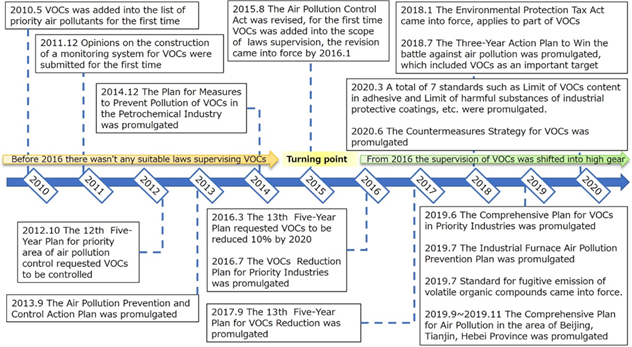The Countermeasure Strategy against VOCs
Background
In China, volatile organic compounds (VOCs) are defined as organic chemicals that have a vapor pressure of 0.01 kPa or more at room temperature (20 °C) or organic chemicals susceptible to photoreactions. VOCs usually originate from automobiles, industrial manufacturing and public use, combustion of any type of fuel, storage and transportation of oil, furniture and machine coatings, cooking oil fume and fine particles (PM2.5). Some VOCs are detrimental to human health or cause harm to the environment.
In recent years, VOC measures have been significantly tightened by the revisions of relevant laws and regulations, all of which started in 2015 (the ”turning point”).The revised Air Pollution Control Act introduced measures for the control and reduction of VOCs. Since the revised act came into force on January 1, 2016, a series of actions have been taken to meet the requirements of the act. The chart below shows the details of such actions from 2010 to 2020.
Timeline of the VOC measures

It should be noted that there have been a few plans focused on the reduction of VOC emissions, such as the “13th Five-Year Plan”, “Three-Year Action Plan to Win the Battle against Air Pollution”, etc., all of which have/had the common target of reducing VOC emissions 10% from 2015 by 2020.
Scope
Although the plans above are not legally binding, they are still important because they stipulate key processes of assessments for pollution control. For example, the “Comprehensive Plan for VOC Control in Key Industries” states how companies in the “key industries” should take VOC control measures and prepare for the assessments.
On the other hand, the Air Pollution Control Act, the overarching legislation for air pollution control, defines two main categories of VOC sources that should be controlled under the legislation.
- Operations (in factories, construction sites, etc.) that have an impact on the air environment or emit pollutants (VOCs) into the atmosphere.
- Production, import, sale and use of materials or products containing VOCs.
Provisions and standards
To control operations that affect the air quality, some provisions have been introduced that set official standards for air pollutant control. The table below shows some of those standards.
| Examples of standards for VOC-emitting operations | ||
|---|---|---|
| Name | Code | Effective date |
| Emission Standard of Air Pollutants for Paint, Ink and Adhesive Industry | GB 37824-2019 | July 1, 2019 |
| Standard for Fugitive Emission of Volatile Organic Compounds | GB 37822-2019 | July 1, 2019 |
| Emission Standard of Air Pollutants for Pharmaceutical Industry | GB 37823-2019 | July 1, 2019 |
There are also provisions that provide standards for the control of materials and products containing VOCs. Some are shown in the table below.
| Examples of standards for materials and products that contain VOCs | ||
|---|---|---|
| Name | Code | Effective date |
| Limits of volatile organic compounds in printing ink | GB 38507-2020 | Apr. 1, 2021 |
| Limits for volatile organic compounds content in cleaning agents | GB 38508-2020 | Apr. 1, 2021 |
| Limit of volatile organic compounds content in adhesive | GB 33372-2020 | Apr. 1, 2021 |
Reference websites
More information about VOC measures is provided on these official websites.
- The Three-Year Action Plan to Win the Battle against Air Pollution – July 2018
http://www.mee.gov.cn/ywgz/fgbz/gz/201807/t20180705_446146.shtml - 7 standards for products containing VOCs or harmful substances – Mar. 2020
http://std.sacinfo.org.cn/gnoc/queryInfo?id=DBFEEDF05290B415CFBBEAA40EA24D78 - The Countermeasure Strategy for VOCs – June 2020
http://www.mee.gov.cn/xxgk2018/xxgk/xxgk03/202006/t20200624_785827.html - The Guidebook to VOC Assessments for Key Industries – June 2020
http://www.mee.gov.cn/ywgz/dqhjbh/dqgdyhjgl/202006/W020200630390174901392.pdf - The Q&A on ozone and VOCs – June 2020
http://www.mee.gov.cn/ywgz/dqhjbh/dqgdyhjgl/202006/W020200630390184097449.pdf - The Practical Manual of VOC Handling – June 2020
http://www.mee.gov.cn/ywgz/dqhjbh/dqgdyhjgl/202006/W020200630390169487941.pdf
EnviX’s view
Entities carrying out operations that emit VOCs into the atmosphere or otherwise affect the air environment should not only observe relevant laws, regulations and standards but also pay attention to such areas as “self-monitoring” and “environmental tax on VOCs”. In 2020, which is the last year of the plans, there are still concerns about how these key areas are addressed.
VOC measures, which used to be mainly focused on commercial operations (in factories, construction sites, etc.), are now gradually shifting its focus to products; foreign manufacturers exporting products to China, as well as companies having factories in the country, are now expected to observe the VOC standards.
It is certain that VOC regulations will become increasingly tighter in the future, so you are encouraged to keep an eye on news about VOC management rules.
 China VOCs, The Countermeasure Strategy
China VOCs, The Countermeasure Strategy
























